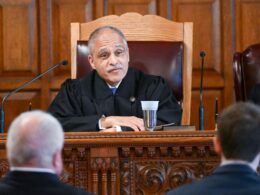On Dec. 12, 2003, an 88-year-old woman was found beaten to death in the bedroom of her Long Island home, shocking the neighborhood that knew the elderly victim as “Grandma.”
Edna Schubert was found dead by concerned neighbors when they saw the front door to her one-story house on Frederick Ave. in North Bay Shore ajar and a broken window on the side of the home, papers flying out the window from the wind, Suffolk County prosecutors said.
The following day Officer Dan Fraas told The New York Times that Schubert, a widow, had been killed by “a violent assault,” but there were no arrests and no one could imagine who could have murdered the kind octogenarian.
For more than 20 years the mystery went unsolved but investigators who worked on the case never forgot the neighborhood’s beloved Grandma and her tragic end.
In 2023, Pasquale Albergo, a retired Suffolk County Police Department detective, having recently read a book about advances in technology in the field of forensic evidence, called the department’s Homicide Section and asked them to reopen the cold case, said Suffolk County District Attorney Ray Tierney.
Images of latent fingerprints from the crime scene were reexamined and photographed using newly available high-definition cameras, leading to crisper images of prints that were found on a window blind and doors of Schubert’s house in 2003, prosecutors said.
The new photos were then fed into the database and yielded a match — to a 29-year-old man who had been living around the corner from the victim at the time of her murder.
But that wasn’t all.

The suspect had also left behind DNA evidence mixed with Schubert’s blood on the pantyhose and T-shirt she had been wearing at the time of her death, Tierney said. That too was a match to Raul Ayala, who was living in tiny Talmo, Georgia, in 2023.
In August, Suffolk County police, a suspect squarely in their sights, traveled to the southern town with a population of 293 to surveil Ayala and collect items containing his DNA. Investigators gathered empty water and Gatorade bottles as well as numerous scratch-off games Ayala had thrown away. The samples matched what was found on Edna Schubert’s clothing.

Ayala was arrested Jan. 16 in Talmo, extradited to New York and arraigned for the 2003 murder Friday, said prosecutors. He is charged with first- and second-degree murder.
Ayala was trying to burglarize the home when he killed Schubert, according to his indictment. He was ordered held without bail by Acting Supreme Court Justice Richard Horowitz.
Facing up to life in prison, Ayala will return to court March 5.
“Everyone in the Suffolk County PD who worked on it, as well as the Suffolk County lab who worked on it, they remembered this case, and they never forgot,” Tierney said at a press conference Friday after the arraignment.
Standing to Tierney’s left was Albergo, who was responsible for reopening the cold case. But the retired detective was prevented from answering any questions from reporters because of his new status on the case — witness.
“Let this case serve as evidence that no matter how much time passes, we will never stop working for victims,” said Suffolk County Police Commissioner Kevin Catalina.
Schubert, who had worked for the Department of Motor Vehicles and been widowed a few years before her murder, never had children of her own, Tierney said. But she was treasured and remembered by many and had photos of neighborhood children displayed in her home.
“She would allow them to ride their bikes in her driveway,” Tierney said. “They would come in for snacks. She helped them with their math homework.
“Everyone called Edna ‘Grandma,’” he said, “because that’s how they thought of her.”








